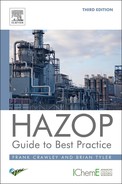Index
Note: Page numbers followed by “f” and “t” refers to figures and tables respectively.
A
Accidents, 36
and recommendations, 21–22
Approved for design (AFD), 5
Area classification, 5
Auditing
external, 55–57
internal, 55–57
B
Batch, 13
Batch/sequential operations, 123
Blowdown, 104
C
Cause and Effects Diagrams, 89
Chemical Industries Association (CIA), 1
Clients, 90
Company procedures, 60
Computer control, 39
Computer controlled processes, 62–69
enhanced HAZOP, 65–67
legislation, 64–65
Continuous operation, 101
Continuous processes, 37–39
Contract operations, 90–91
D
Demolition, 89–90
Design, 1
generating, 15–17
Down hole safety valve (DHSV), 101
Drains, 82–84
E
Enhanced HAZOP, 65–67
Environmental risk, 29
Ergonomics, 11
European Process Safety Centre (EPSC), 1–2
F
Failure modes and effects analysis (FMEA), 67–68
Functional safety, 64–65
G
Generic actions, 21
H
Hazard studies, 4
checklist, 8–9
overview, 30
applications, 77
existing plant, 78–79
pitfalls, 92
purpose, 11
HAZOP example batch operation, 123
documentation, 125–128
guidewords, 129–130
P&ID, 125–128
parameters, 130
plant and process, 123
process description, 128
reaction stage description, 131
HAZOP example continuous process, 101
issues, 104–105
methodology, 105–121
node 1 records, 114t
node 2 records, 118t
process data, 104
process description, 101
team members, 105–106
HAZOP example procedure, 139
description, 139–141
operating sequence, 142
P&ID, 140f
review, 149–150
study records, 149
team members, 139
HAZOP study
alternatives, 7f
background, 1
batch processes, 39–41
commissioning, 84–85
completion, 22–23
computer-controlled process, 62–69
conceptual model, 10
construction, 89–90
continuous processes, 37–39
contract operations, 90–91
decommissioning, 84–85
demolition, 89–90
description, 13–15
design envelope, 10
design intent, 13–15
deviations, 15–17
drains and vents, 82–84
enhanced, 65–67
existing plant, 10–11
ground rules, 46
illustration, 23–26
interconnections, 82–84
laboratory operations, 80–82
legislation, 4
limitations, 11–12
links to LOPA, 74–76
operating procedures, 79–80
operational modes, 31
pilot plants, 80
pitfalls, 92
purpose, 11
repeat designs, 78
shutdown, 88–89
start-up, 85–89
successful, 92
team size, 33–36
HAZOP study meetings
follow up, 48–49
initial meeting, 46
planning, 45–46
responses, 47
signing off, 48
study sessions, 46–47
knowledge-based mode, 69–70
rule-based mode, 69–70
skill-based mode, 69–70
Human Reliability methodology, 72
I
ICI, 1
IEC 61508, 64–65
Inherent safety, 6
Interfaces high/low pressure, 83
L
Laboratory operations, 80–82
Licensors, 90
M
Major Accident Prevention Policies, 4
Management of Change Procedure, 48
Material properties, 37
Material Safety Data Sheet (MSDS), 51
Meetings
duration, 45–46
initial, 46
planning, 45–46
Mentoring, 59
N
Near misses, 39
O
Operability problems, 4
Operator training, 50
P
Performance-influencing factors (PIFs), 72–73
Periodic hazard studies, 78–79
Pilot plant, 80–82
Planning, 37–38
Plant safety dossier, 50
Post-HAZOP work, 94
Pre Start-up Safety Review (PSSR), 6
Pre-meeting with client, 43–45
inclusions, 43
terms of reference, 43
Preparation, 36–42
Procedure HAZOP, 139
Process and instrumentation diagram (P&ID), 5, 37, 43, 44, 65, 79, 82, 82, 83, 92–93, 109f, 111f, 113f, 125–128, 140f
Process hazard studies, 4
Process safety management (PSM), 4
Programmable electronic systems (PES), 62
Project life cycle, 7
Protection, 19
Pump, 18–19
Q
Quality, 12
Quality assurance (QA), 29
Quantitative risk assessment (QRA), 12
R
Reaction stability, 80–81
Realistic causes, 18
Recommendations, 21–22
Record, content, 54
background information, 51
computer recording, 54–55
content, 54
format, 51–52
level, 52–54
section headings, 51
uses, 50
Repeat designs, 78
Report completing, 48
Reporting, 67
Responses
coordinating and reviewing, 47
environmental, 29
Risk graph, 3f
S
Safe Holding Position, 88
Safety and Operability Review (SOR), 63
Safety management systems (SMSs), 4
Sequential operations, 39–41
Seveso II Directive, 4
Special skills, 82–83
System parameters, 2–3
T
membership, 33–36
scribe, 32–33
selection, 31–36
size, 33–36
Training, 58
members, 58
scribe, 58
team leader, 58–59
V
..................Content has been hidden....................
You can't read the all page of ebook, please click here login for view all page.
